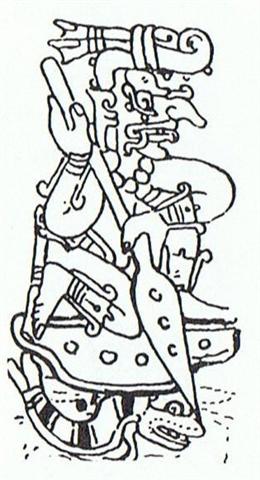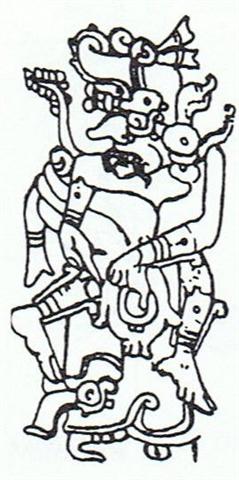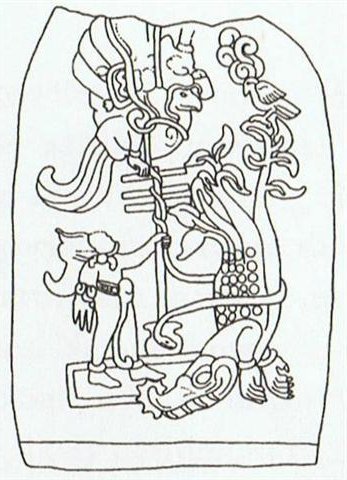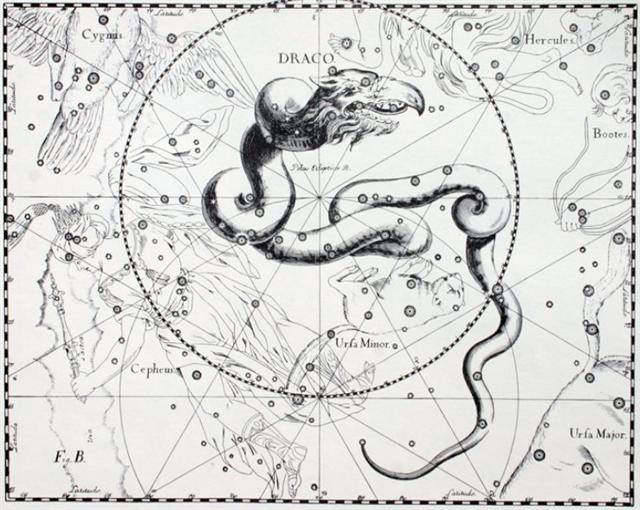Once again. The Sea Dragon (Imix) was at the beginning, high up and carrying the Sun forward on his head:
Later, at high summer, the Sun would turn around because he could not climb any higher. He had to change sex and become as one with his Smoking Mirror image (Tezcatlipoca):
... But the time of his predestined defeat by the dark brother, Tezcatlipoca, was ever approaching, and, knowing perfectly the rhythm of his own destiny, Quetzalcoatl would make no move to stay it. Tezcatlipoca, therefore, said to his attendants, 'We shall give him a drink to dull his reason and show him his own face in a mirror; then, surely, he will be lost'. And he said to the servants of the good king, 'Go tell your master that I have come to show him his own flesh!' But when the message was brought to Quetzalcoatl, the aging monarch said, 'What does he call my own flesh? Go and ask!' And when the other was admitted to his presence: 'What is this, my flesh, that you would show me?' Tezcatlipoca answered, 'My Lord and Priest, look now at your flesh; know yourself; see yourself as you are seen by others!' And he presented the mirror. Whereupon, seeing his own face in that mirror, Quetzalcoatl immediately cried out, 'How is it possible that my subjects should look upon me without fright? Well might they flee from before me. For how can a man remain among them when he is filled as I am with foul sores, his old face wrinkled and of an aspect so loathsome? I shall be seen no more, I shall no longer terrify my people'. Presented the drink to quaff, he refused it, saying that he was ill; but urged to taste it from the tip of his finger, he did so and was immediately overpowered by its magic. He lifted the bowl and was drunk. He sent for Quetzalpetlatl, his sister, who dwelt on the Mountain Nonoalco. She came, and her brother gave her the bowl, so that she too was drunk. And with all reason forgotten, the two that night neither said prayers nor went to the bath, but sank asleep together on the floor. And in the morning Quetzalcoatl said, in shame, 'I have sinned; the stain of my name cannot be erased. I am not fit to rule this people. Let them build a habitation for me deep under the ground; let them bury my bright treasures in the earth; let them throw the glowing gold and shining stones into the Precious Waters where I take my nightly bath. And all this was done. The king remained four days in his underground tomb, and when he came forth he wept and told his people that the time had come for his departure to the Red Land, the Dark Land, the Land of Fire ... ... Ta'aroa sat in his heaven above the earth and conjured forth gods with his words. When he shook off his red and yellow feathers they drifted down and became trees. He created the first parents, Tumu-nui, Great Foundation, to be the husband, and Paparaharaha, Stratum Rock, to be the wife. He put the very essence of himself into their creation; yet when he commanded them to wed, each refused to go to the other. So Ta'aroa created other gods and Atea, Bright Expanse, the Sky-goddess, who dwelt in darkness in the confined sky Rumia. By Papa-tuoi, Thin Earth, Atea was the mother of children who became artisans for Rai-tupua-nui, Great-Sky-builder. They assisted him in erecting the ten heavens above the earth. In the highest of these dwelt the god Tane, so it was called the Sky-of-the-sacred-omens of Tane and Sky-of-the-water-of-life of Tane. The next highest heaven was called Hiro's Sky-of-prophets. Atea then became the wife of Rua-tupua-nui, Source of Great Growth, and they became the parents of all the celestial beings, first the shooting stars, then the Moon and the Sun, next the comets, then the multitude of stars and constellations, and finally the bright and dark nebulae. When this tremendous task had been accomplished Atea took a third husband, Fa'a-hotu, Make Fruitful. Then occurred a curious event. Whether Atea had wearied of bringing forth offspring we are not told, but certain it is that Atea and her husband Fa'a-hotu exchanged sexes. Then the [male] eyes of Atea glanced down at those of his wife Hotu and they begat Ru. It was this Ru who explored the whole earth and divided it into north, south, east, and west ... However, in the Golden Age when the constellations were created in good order, to be in time with the seasons and with the Milky Way, this band across the night sky was not like a great Tree at all but like a majestic River transporting the Sun across from one equinox to the other, from one side of the sky to the complementary side.
... The basic myth of dynastic Egypt was that of the death and resurrection of Osiris, the good king, 'fair of face', who was born to the earth-god Geb and sky-goddess Nut. He was born together with his sister-wife, the goddess Isis, during the sacred interval of those five supplementary days that fell between one Egyptian calendric year of 360 days and the next. He and his sister were the first to plant wheat and barley, to gather fruit from trees, and to cultivate the vine, and before their time the races of the world had been savage cannibals [meat eaters]. But Osiris's evil brother, Set, whose sister-wife was the goddess Nephtys, was mortally jealous both of his virtue and of his fame, and so, stealthily taking the measure of his good brother's body, he caused a beautifully decorated sarcophagus [meat eater] to be fashioned and on a certain occasion in the palace, when all were drinking and making merry, had it brought into the room and jestingly promised to give it to the one whom it should fit exactly. All tried, but, like the glass slipper of Cinderella, it fitted but one; and when Osiris, the last, laid himself within it, immediately a company of seventy-two conspirators with whom Set had contrived his plot dashed forward, nailed the lid upon the sarcophagus, soldered it with molten lead, and flung it into the Nile, down which it floated to the sea ... 360 - 72 = 288 = 472 - 184. In Roman times - after Julius Caesar had restored the ancient beautiful order which had gone out of tune - the Front of the Head of Ku (the Sea Beast, Imix) was at 0h, but anciently the front of his head had been at a place 6 days earlier than *FEBRUARY 14 (45 = 360 / 8):
When at that ancient time Thuban had been at the Full Moon and the Sun had reached the Knot (Al-Risha), it would have been 406 - 355 = 51 nights after the solstice. And 3 further nights ahead - in night number 51 + 3 = 54 (= 2 * 27) counted from the solstice - was the final of the Old Year. And then followed the place for All Hearts (2-14) with the wonderful star Mira (ο) blinking like a beacon at the throat of Cetus :
... In the inscriptions of Dendera, published by Dümichen, the goddess Hathor is called 'lady of every joy'. For once, Dümichen adds: Literally ... 'the lady of every heart circuit'. This is not to say that the Egyptians had discovered the circulation of the blood. But the determinative sign for 'heart' often figures as the plumb bob at the end of a plumb line coming from a well-known astronomical or surveying device, the merkhet. Evidently, 'heart' is something very specific, as it were the 'center of gravity' ... See Aeg.Wb. 2, pp. 55f. for sign of the heart (ib) as expressing generally 'the middle, the center'. And this may lead in quite another direction. The Arabs preserved a name for Canopus - besides calling the star Kalb at-tai-man ('heart of the south') ... Suhail el-wezn, 'Canopus Ponderosus', the heavy-weighing Canopus, a name promptly declared meaningless by the experts, but which could well have belonged to an archaic system in which Canopus was the weight at the end of the plumb line, as befitted its important position as a heavy star at the South Pole of the 'waters below'. Here is a chain of inferences which might or might not be valid, but it is allowable to test it, and no inference at all would come from the 'lady of every joy'. The line seems to state that Hathor (= Hat Hor, 'House of Horus') 'rules' the revolution of a specific celestial body - whether or not Canopus is alluded to - or, if we can trust the translation 'every', the revolution of all celestial bodies. As concerns the identity of the ruling lady, the greater possibility speaks for Sirius, but Venus cannot be excluded; in Mexico, too, Venus is called 'heart of the earth' ... |
||||||||||||||||||||||||||||||||||||||||||||||||||||||||||||||||















